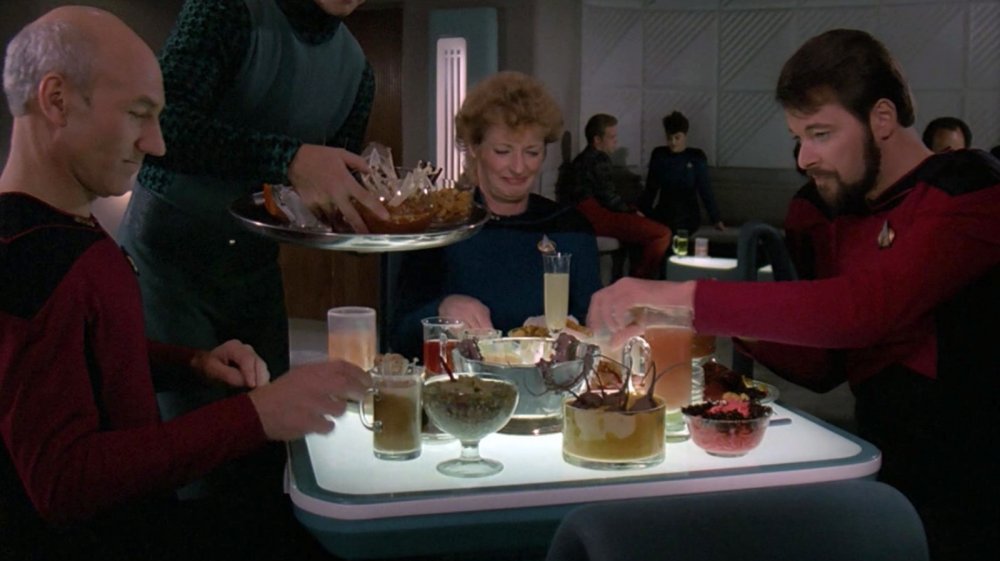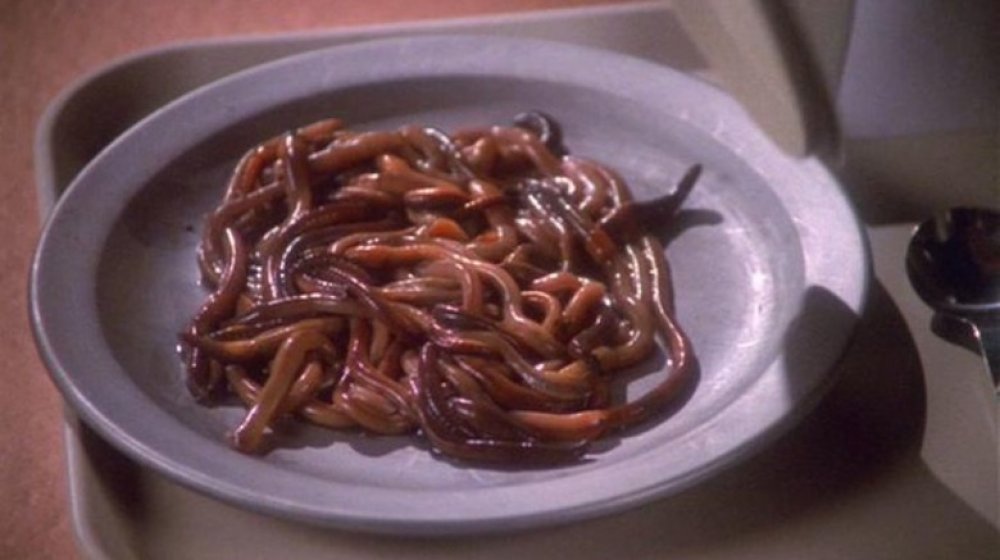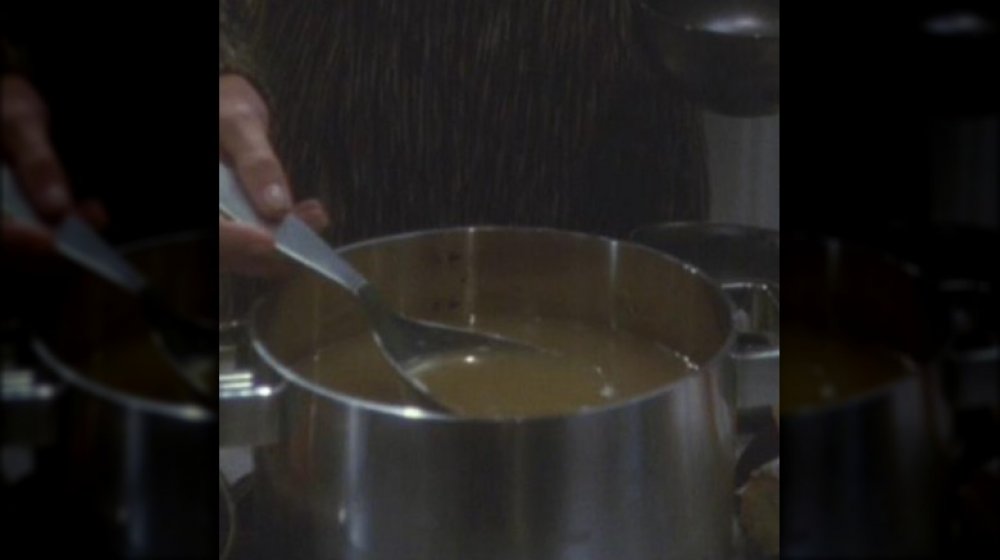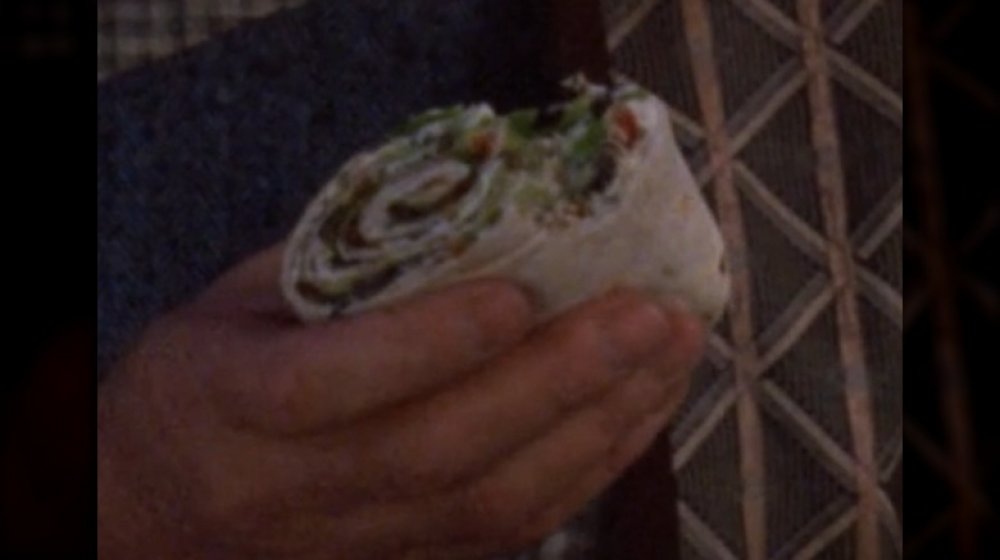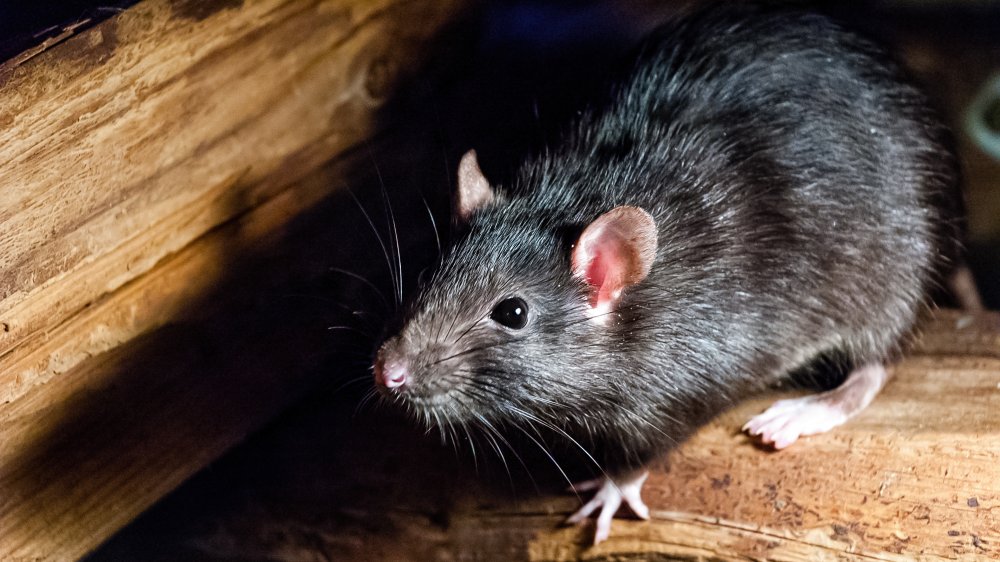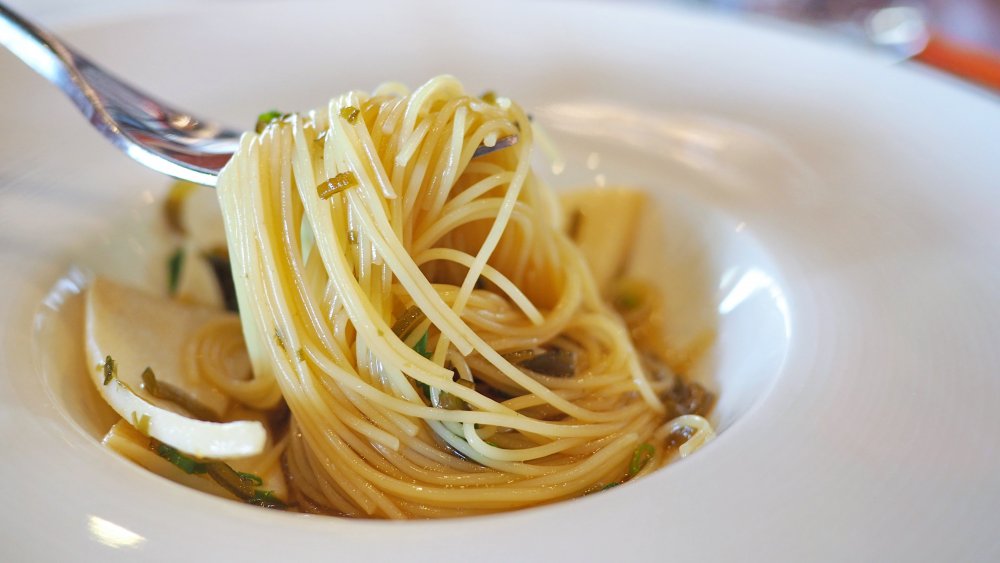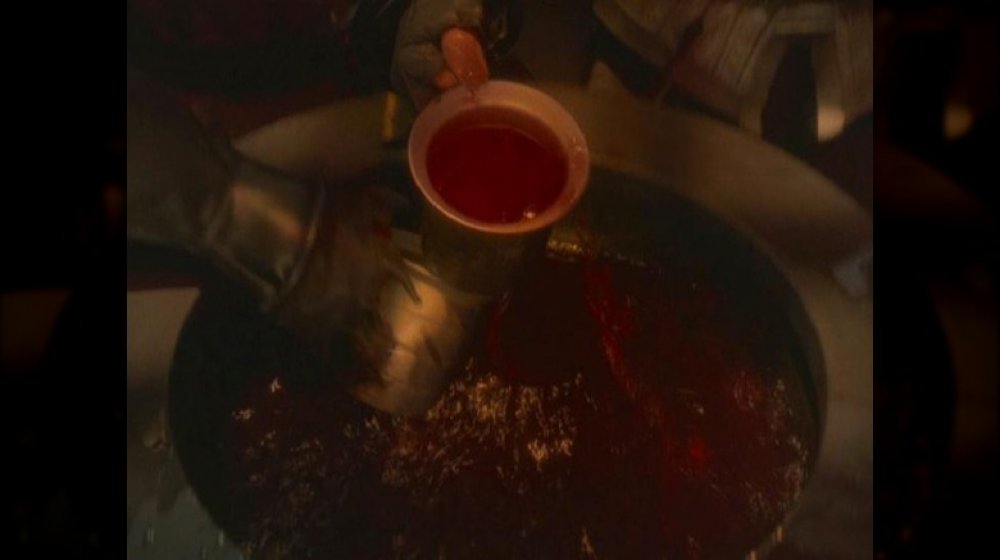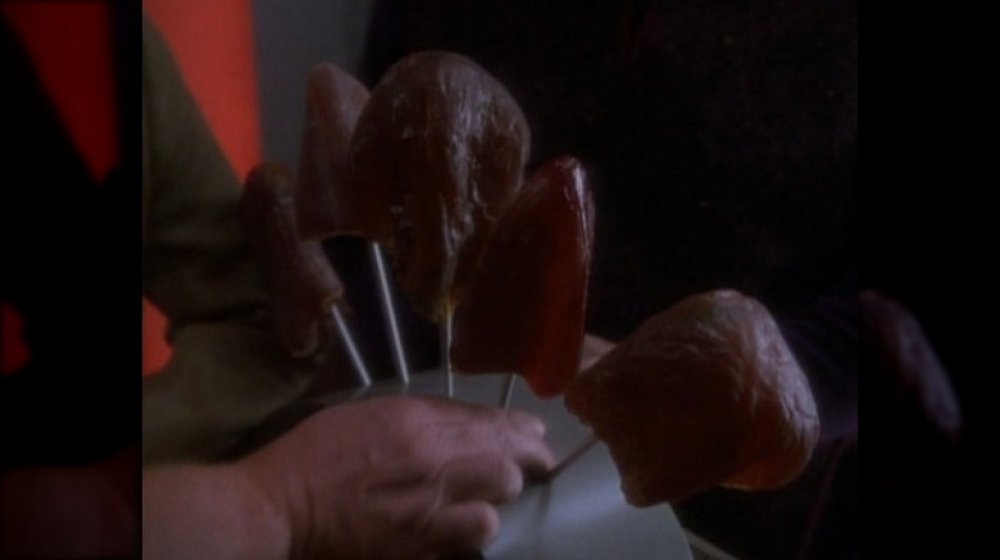The Bizarre Food On Star Trek Explained
Star Trek has existed in one form or another for more than 50 years. In pop culture terms, that's infinity — many people have literally never known a world without Star Trek. So far, there have been ten television series, 13 theatrical films, and countless novels, comic books, games, and other media. That's a lot of material and world-building. At this point, Star Trek may be the most finely detailed fictional universe ever created.
Many of those details are in the service of creating convincing alien cultures. Star Trek contains alien civilizations at just about every level of technological and cultural advancement, and it's unusual in that humanity isn't presented as the center of everything. Earth culture is very much just one of many and is often presented as being a bit backward in some ways, a bit advanced in others — for example, food.
Food plays a surprisingly important role in the Star Trek universe. Several stories pivot on shared meals, characters bond over their favorite dishes and reveal themselves in how they react to unfamiliar dishes, and alien cultures are illuminated by what they eat and how they treat the rituals of food preparation and consumption. Since a lot of this is alien food, it can get a little crazy, of course. Here are some of the more extreme examples of the bizarre food on Star Trek explained.
Gagh
Klingon gagh is one of the most famous dishes in the Star Trek cookbook, in part because Klingon culture is such a big and fascinating part of the universe and in part because gagh is, frankly, disgusting. There's no easy way to say this: It's worms. Specifically, fictional serpent worms — preferably eaten alive and wriggling — which makes sense since the Klingons are a warlike, aggressive race of people who value individual courage and honor. You can see where making every meal a predatory victory would appeal to them.
According to the Star Trek wiki Memory Alpha, the Klingon dish comes in about 51 varieties (in large part because the many, many writers on the many, many series and films weren't particularly consistent with how gagh was described or presented). Luckily for the human characters, some of these involve stewing or chilling the worms, meaning it's a slightly less horrifying eating experience. This might explain why so many Star Trek fans are obsessed with actually preparing gagh and eating it, despite the fact that serpent worms don't actually exist.
As reported by Vice, there's significant interest and energy put into trying to create something vaguely resembling gagh in real life. Unsurprisingly, most of these efforts don't actually involve living worms but use worm-like stuff like pasta, noodles, or overcooked veggies to approximate the experience. Of eating worms. Because that's an experience you want to approximate, apparently.
Romulan ale
One of the most famous consumables ever mentioned in the Star Trek universe is Romulan ale, an incredibly powerful intoxicant with an iconic blue color. (It sometimes appears to be phosphorescent as well.) As the Romulans are usually Federation enemies, Romulan ale is usually illegal. Serious Eats notes that this is often presented as a parallel to real-world Cuban cigars: something highly prized and considered extremely high-quality that is illegal for purely political reasons. Though, to be fair, it is sometimes implied that Romulan ale is also illegal because of its potency — for many, it apparently results in instantaneous inebriation, followed quickly by incapacitation. As Memory Alpha notes, even Worf, who enjoys a Klingon's robust constitution, is affected powerfully by the stuff.
Naturally, the combination of extreme intoxication and bright blue color makes it a common example of Star Trek fare that people try to create in real life. The good news is that Romulan ale has never been described in great detail, so all you need to do is make a really, really strong drink that has a really, really blue color to it. There are several recipes on the Internet for cocktails you can reasonably call Romulan ale, most of which involve everyone's go-to blue liqueur, blue curaçao, and everybody's go-to alcoholic dynamite, Everclear. This one packs a punch, for example.
Plomeek soup
The Vulcans are just as important to Star Trek as the Klingons in terms of alien races. Spock, portrayed by the late Leonard Nimoy and later by Zachary Quinto, remains one of the most popular characters in the show's universe. And the Vulcans are at the center of many of Star Trek's most important storylines.
But Vulcan cooking isn't given as much attention on the show as the Klingons' or even some other, less important alien races. That's largely because the Vulcans, being ultra-rational beings, don't treat their meals like violent deathmatches as the Klingons do, and they also embrace a vegetarian lifestyle that simply isn't particularly exciting. But one Vulcan dish does get a lot of attention: plomeek soup.
As Westword explains, plomeek soup is a traditional breakfast meal for Vulcans and is basically a very bland vegetable broth. Its most famous moment of screen time comes in the classic Original Series episode "Amok Time," when Spock goes through the Vulcan mating cycle known as pon farr. Nurse Chapel prepares some plomeek soup in an attempt to comfort and calm Spock. It does not go well and represents one of the rare times Spock (or any Vulcan) displays an emotional reaction.
If you're hankering for some tasteless veggie broth (and who isn't), Buzzfeed offers a simple recipe for something approximating the fictional version.
Heart of targ
A lot of the food mentioned during Star Trek's five-plus decades of existence is recognizably traditional human fare jazzed up with some funny names and food dyes. Sometimes you can imagine the writers just taking any earthbound meal and tacking the name of an alien race at the beginning, like Talaxian omelettes or Ktarian beer (which looks a lot like regular beer).
Klingon food, however, is reliably weird. The Klingons are a sneering, violent race, after all — but a sneering, violent race with a rich culture. Even when their culinary achievements can be traced back to relatively normal human equivalents in the real world, there's usually a violent and terrifying twist to them. Such is the case with heart of targ.
As Memory Alpha explains, a targ is essentially a boar, except with spikes on its back and a tendency to destroy everything in its path. Naturally, the Klingons keep targs as pets and enjoy eating them in a dish called heart of targ which, you guessed it, involves the heart torn from a targ. The Klingons believe eating it confers courage, so they naturally eat it a lot. Horrifyingly, Buzzfeed reports that Food Replicator, a food blogger, has actually created this dish in the real world using lamb's hearts.
Rokeg blood pie
The Klingons in Star Trek have a rich legacy of poetry, art, and aggressively violent interactions with everyone, including themselves. They're also all about their food. But the Klingons can't just make a delicious, nutritious meal. They generally have to work some kind of off-puttingly violent imagery into it ... or simply make it kind of gross, food that requires courage just to eat.
As a result, an unsurprising number of Klingon foods include the word "blood." In fact, when the Klingons aren't eating stuff like live worms, their food seems to have a disturbingly high blood content. Case in point: Rokeg blood pie. Because who doesn't want their daily recommended serving of blood served in pie form?
To be fair, human beings have a fair number of blood puddings and the like, so it's not like the Klingons invented eating the coagulated blood of other beings. Star Trek does a great job of making the food in its stories meaningful, however, and as Memory Alpha notes, Rokeg blood pie is notable as being a comfort food for the Klingon character Worf. It's also traditionally consumed on the Klingon Day of Honor, when warriors looks back on their deeds and judge their honor.
Recipes exist, but be warned: Most use more palatable stuff like raspberry puree. If you want to make the real stuff, Food Replicator has a recipe that uses real blood. You have a blood guy, right?
Pipius claw
When the subject of weird alien food on Star Trek comes up, it usually centers on Klingon dishes. This makes sense because the Klingons are both a fantastic creation, equal parts violence and poetry, and a collection of bizarre, off-putting cultural details. Their food reflects this. Most of the Klingon dishes mentioned in the show sound revolting or like the sort of prank dish kids are forced to eat when rushing a particularly cruel fraternity.
Take pipius claw, which the ever-adventurous Commander Riker ate in the TNG episode "A Matter of Honor." Riker was being temporarily assigned to a Klingon ship and wanted to acquaint himself with the culture via a traditional meal.
If you're wondering how awful something called pipius claw would be in real life, Memory Alpha notes that Alan Sims, the guy who created the food prop for the episode, used chicken feet with one of the toes cut off. The legs were then placed in a liquid broth of some sort and garnished with some colorful vegetable matter. While it's true that people do actually eat chicken feet in real life, we maintain that when the best thing you can say about dinner is that it resembles chicken legs, you've already lost.
Hasperat
If you're planning some sort of Star Trek-themed dinner party, you might look into meals that can be approximated by real-life recipes, if only to avoid serving a bowl of wriggling worms to your impressed but horrified guests. That makes hasperat an ideal choice, because, as Memory Alpha notes, all we really know about this Bajoran food is that it resembles a burrito and is so hot and spicy it makes the eyes water and literally burns the tongue. That means that all you need to do is make something vaguely burrito-like and make it spicy AF. In fact, the prop food used in the series was as basic as it comes: flour tortillas, cream cheese, and red and green peppers.
That simplicity makes it ideal for themed party food because it's easy, and attaining a level of verisimilitude is easy enough — they're just space wraps, after all. The challenge lies in the heat level. If you want an authentic Star Trek hasperat experience, those babies have to be hot, hot, hot. Recipes found at places like Food.com or The Geeky Chef both call for hot sauce but leave it up to you for the level of fire (and the choice of sauce). Whether you make them mildly spicy or thermonuclear, hasperat remains one of the few Star Trek meals you can replicate in your kitchen with a reasonable resemblance to the real (fictional) food.
Stewed Bok-Rat Liver
Ah, those kooky Klingons and their aggressively terrible food. The persistently unappetizing nature of Klingon dishes is one reason their food is the most memorable on the show — and why it's always the Klingon meals that fans try to make in real life.
A prime example is stewed bok-rat liver. You might think no one in their right mind would want to eat any part of a rat, but as Practical Self Reliance points out, rats and mice have been considered delicacies in many cultures throughout history. According to Food Replicator, this dish is a staple of Klingon warships and is best enjoyed fresh.
Unfortunately, as with most Klingon meals, it's not meant to be appetizing to us regular humans. As Memory Alpha notes, in the script of the Deep Space Nine episode "Soldiers of the Empire," the dish is described as "vile and slimy," which might be exactly what a bunch of Klingon warriors serving in a crowded, stuffy warship for years on end look for in a comfort food but doesn't work so well with human beings. Or at least not normal human beings.
Luckily, the recipe that Food Replicator offers (using lamb's liver) actually sounds delicious — assuming you like liver to begin with.
Alfarian hair pasta
At first glance, Alfarian hair pasta sounds like the classic sci-fi technique of taking something perfectly normal and mundane and adding a sci-fi word in front of it, like "space madness." In this case, take some (angel) hair pasta, attribute it to the Alfarians, and call it a day.
But Alfarian hair pasta is actually a lot more interesting and a lot weirder than you might think at first glance, mainly because the word "hair" isn't so much a descriptive adjective as it is literally what you're eating. Have you ever considered eating the wool from a sheep? If not, it's possibly (probably) because of your provincial human outlook on life. As Memory Alpha explains, the hair of the Alfarians is edible, and every year when they begin to shed, their hair is gathered up, cooked, and eaten.
Luckily, Alfarian hair pasta looks more or less like traditional human pasta (thank goodness for the traditionally low budgets of Star Trek TV shows), so recipes like the one offered at Food Replicator are pretty easy to make — although whether or not your obsession extends to actually making your pasta from scratch is entirely up to you.
Bloodwine
Because the Star Trek writers traditionally understand the cultural power and importance of food, the Klingon culinary arts get a surprising amount of attention in the various TV shows and films. While sometimes, these mentions of food and drink are just set dressing or provided for shock value, they can also provide a great deal of depth to the fictional cultures of the universe. Klingon bloodwine is a great example of this.
As Memory Alpha explains, bloodwine is a staple alcoholic beverage for the Klingons. It's powerful stuff, considered much stronger than whiskey — in fact, most non-Klingons can't tolerate it. At the same time, it has vintages like our wines, so it's a varied experience. Klingons often have favorite vintages and will stock up on a particular year to drink on special occasions. Served warm and very strong, like most Klingon food and drink it's almost certainly disgusting unless you're drinking one of humanity's many versions of it.
Interestingly, there's no official proof that bloodwine actually contains blood, though there are non-canonical sources that suggest it's made from blood and sugar (yum). Most of the recipes created to approximate bloodwine don't actually call for blood – Cook Fiction's recipe, for example, uses grenadine and cranberry juice to give the cocktail that bloody look.
Jumja sticks
One of the more subtle and effective bits of world-building employed by the writers of Star Trek is the varied reactions to the alien foodstuffs mentioned in the stories. Having some characters love a dish while others react in horror is a small detail, but it really helps to sell a universe with real depth. In real life, there are plenty of food items that divide people.
That's what makes jumja sticks so interesting. These typically huge treats are made by Bajorans from the sap of the jumja tree. According to Memory Alpha, jumja sticks are really, really sweet. And like many sweet treats, jumja sticks can be flavored in various ways. As a result, creatures with a sweet tooth tend to love them, while many others find them to be cloying and kind of gross. They're kind of the Peeps of the Star Trek world, in other words. In fact, behind the scenes, jumja sticks were referred to as "glop-on-a-stick," which gives you some idea of just how appetizing they were intended to be.
If you're wondering what a jumja stick might taste like, some have suggested that maple syrup sugar candy could be used to approximate them. Food Replicator suggests treacle, which seems like a better match in terms of sweetness and how quickly you'll get very, very tired of eating them.
Klingon skull stew
The Klingon diet is not for the faint of heart. Just about every dish has words like "blood" or "heart" in the name, and these should be taken very, very literally. They also tend to be pretty accurately described — no foodie poetry for the Klingons. So if you glance at your menu and see that you're being served Klingon skull stew, you know a skull is going to be involved. The only question is whether it'll be a Klingon skull or ... something else.
According to Memory Alpha, Klingon skull stew appeared in one and perhaps two episodes of different Star Trek series. In Deep Space 9, Klingon skull stew is offered by the Replimat, along with a blurry photo depicting it. In Enterprise, an unnamed stew-like dish is shown being prepared on a Klingon ship with an obvious skull floating in it.
The Star Trek Cookbook – which isn't considered canon but is still fun to read – includes a recipe for Klingon skull stew using a calf's skull (naturally) and honeycomb tripe (also naturally). Which means that skull stew may be the only Star Trek meal that is actually more horrifying in its real-world approximation than its fictional version.
